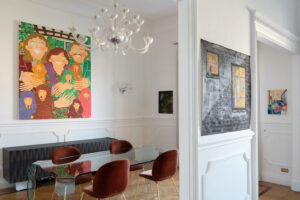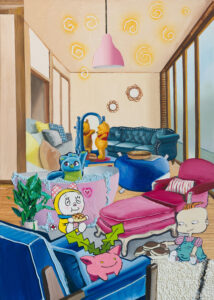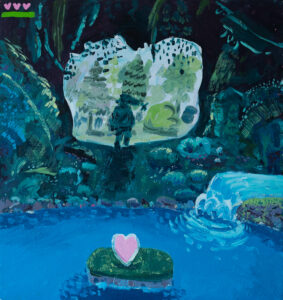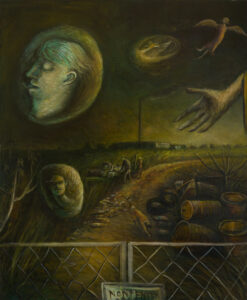“New Origins-Level Unlocked”, the collective exhibition proposed by Andrea Festa Fine Art Gallery in Rome, points out, in the work of individual artists, a primary attitude to vision and the liminal boundaries of vision. The dialogue between the curator Benedetta Monti and some of the authors who took part in this project clarifies the meaning and motivations.

Installation View, “New Origins-Level Unlocked”, Andrea Festa Fine Art Gallery, 2023 © credits Eleonora Cerri Pecorella, courtesy Andrea Festa Fine Art Gallery
B.M.: Art has often seen the use of irony and derision as a means of deconstructing reality. How do you think irony finds its place in today’s art and how does this theme intersect in your work?
Minyoung Kim: The irony in my work is one of the most important factors. The ironic scenes that create laughter along with feelings of eccentricity and fear are a reflection of my inner state. I want to create a contradictory situation, in which the situation in the work is serious and not, embodying the encounter between disparate elements, such as the combination of pain and ridicule, extraneousness and familiarity. In my work cats express themselves above all as a representative element of irony. The mixture of danger and humor in the images I use in my paintings can be seen as a mixture of heterogeneity, a dissonance of grotesque features.
B.M.: Folklore, fairy tales and oral tradition have created gods and goddesses, myths and legends, and influenced the artistic language of many artists. How does this talk fit into your practice and contemporary art in general?
Ralf Kokke: Ancient stories like Adam and Eve, but also contemporary stories like Peter Pan, have had a big impact on the way I see the world. These stories speak of good and evil and the possibility of making mistakes. Peter Pan’s story reminds me of growing up and leaving the carefree days of childhood behind. It is a universal struggle: we all want to keep our youth, but in the end we have to face the reality of becoming adults. I use these stories in my work to understand my life and experiences. My work explores the tension between the desire for freedom and the need to grow and face the world.

Vanessa Morata, “New Origins-Level Unlocked”, Andrea Festa Fine Art Gallery, 2023 © credits Eleonora Cerri Pecorella, courtesy Andrea Festa Fine Art Gallery
B.M.: The theme of the house is dear to you in your work, and there are elements that look at the collective imagination of children and cartoons. Can you explain why?
Vanessa Morata: Contemporary consumerism is not only nourished by material things, but also by images. My generation is hovering between analog and digital. We had cassettes, CDs, VHS, we had the first cell phones and the first computers with the Internet. Television was a key presence in our homes. We grew up with Disney, Doraemon, Olly and Benji, Looney Tunes… These series and films constitute a collective imagination that is part of contemporary visual culture: a culture that we share and identify with. I use the house as the memory of the individual or the nostalgia of wanting to own part of our childhood through these cartoons, as collectibles, along with the desire to purchase empowerment. Consumer products coexist with the collective imagination of children united in the same place.
B.M.: In your work characters are often taken from the world of video games and are humanized, until they become an uncomfortable vision, going towards the visual détournement. How do you solve this in your creative process?
Jesse Morsberger: With the Internet, it is easier than ever to find the starting material for paintings, project on a canvas and make a perfect copy of something. With my paintings, I’m fighting this. Even though I use video game celebrities in my work, what I’m doing doesn’t depend on the appearance or behavior of those characters. I’m painting the memory of these things and bringing them some humanity. By painting these digital worlds, I’m trying to give them back the feeling of pure joy and discovery that I felt when I first played the games they came from.

Jesse Morsberger, “Heart Container”, 2022, © credits Eleonora Cerri Pecorella, courtesy Andrea Festa Fine Art Gallery
B.M.: In your work the human figure is a common denominator. What are your stylistic influences and how do Mediterranean influences play a role in your work?
Chris Akordalitis: After a long period of exploration I remember a comment from my professor: “To your paintings you can say that you come from a land with a lot of light”. From that moment I wanted to bring a lot of that light into my work. Elements of home that are actually parts of me. Bright colors, flowers and fruits, the sea and shells. Elements that symbolize and refer to a feeling of warmth, to the memory of a smell or a taste. I like to play with the Mediterranean nature, sometimes turning it into an exotic daytime atmosphere with blue skies or a starry night of a sparkling summer. In every work I want to embrace the human body while trying to tell a story. Naked and exposed, vulnerable and with nothing to hide, my characters show their emotions and intentions.
B.M.: In your works there is the taste of a gaze still in love with your roots between South London and Southeast Asia. How have your communities affected your creative process? Can we say we glimpse a relationship between materiality and diaspora?
Alya Hatta: The communities around me have always influenced my creative process, as well as influencing the formation of my identity. There is constant inspiration in trying to create connections between East and West. I aim to look closely, collecting plots, stories, colors, plant life and materials from the market and everything that bridges the gap between where I am now, where I have been and where I will go. Narration and materiality are the means I choose to express the diaspora in many ways. One of them is the integration of my clothes into the works. The clothes I wear are the armor that has taken me to countless places, experiences and emotions and are also the physical representation of an identity.

Taichi Nakamura, “New Origins-Level Unlocked”, Andrea Festa Fine Art Gallery, 2023 © credits Eleonora Cerri Pecorella, courtesy Andrea Festa Fine Art Gallery
B.M.: You can see many metaphysical and surreal visual links in your work, what can you tell us about your process and your style?
Taichi Nakamura: I like to fish and I am interested in the natural environment, also from the Buddhist point of view. I’m interested in all the cycles that repeat. When I was a child, rivers were dirty and the negative effects of Japan’s economic growth were often visible in the landscape. Now there are more complex environmental issues. Rivers are cleaner than before. I want to feel the changes more subtly. I draw stories on the border between dream and reality. The journey of life is told in life and death repeated. My stories are often set in the desert. Even the land I grew up in is on the outskirts of a big city. It was a life on the border between the city and the countryside. I like that kind of scenario, and it’s naturally rooted in my corpus of work. So my new story will also be drawn in my favorite lands.
Info:
AA.VV., New Origins-Level Unlocked
Curated by Benedetta Monti
10/02/2023 – 25/03/2023
Andrea Festa Fine Art Gallery
Lungotevere degli Altoviti, 1 – Rome

is a contemporary art magazine since 1980






NO COMMENT